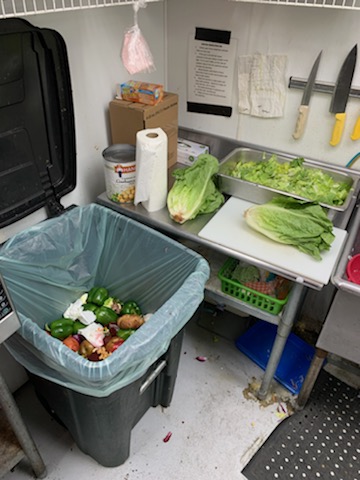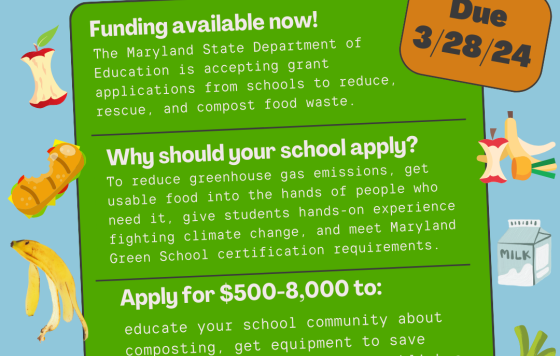
Last year, we worked hard to pass HB264/SB483, which moves Maryland toward Zero Waste by making sure the the biggest producers of food waste are composting it if they can. And this year, it's time for those new rules to be put into action!
One of the first steps is for the Maryland Department of the Environment to publish draft regulations and invite the public to comment. Those draft regulations will help move Maryland toward zero waste, but there are ways they could be made even better. Read our comments on the draft regulations with 20 organizations, and contact us to get involved. Next step: publication of revised draft comments in the MD Register!
July 21st, 2022
David Mrgich, Waste Diversion Division Chief
Land and Materials Administration
Maryland Department of the Environment
1800 Washington Boulevard, Suite 610
Baltimore, Maryland 21230-1719
RE: COMAR 26.04.13 Food Residuals – Organics Recycling and Waste Diversion
Dear Mr. Mrgich,
Thank you for the opportunity to provide comments. We urge MDE to make the following changes to the draft regulatory language and compliance guidelines before they are published in the Maryland Register.
- Change the definition of “Food Residuals” to exclude non-compostable packaging, in order to avoid contamination and spur production of high-quality compost products. Source-separation of organics from non-compostable material is crucial to building and maintaining robust organics recycling infrastructure in Maryland. The regulations should encourage food residuals to be removed from non-compostable packaging and separated at the point of generation.
- Clarify that generators may choose to send their food residuals to any organics recycling facility, not just the closest one within the 30-mile radius, if they choose to recycle with a third party instead of or in addition to reducing, reusing, rescuing, or recycling on-site.
- Clarify that food waste generators don’t have to divert all their material to one site.
- Specify that all organics recycling sites regardless of size can accept a food generator’s food residuals in whole or in part for recycling, as long as they have capacity. For instance, farmers who want to compost only vegetable and food scraps are an allowable recycler and should be encouraged.
- Clarify how the “average” tonnage is measured in section .03(A)(a) and (b). Is it an annual average? Is it the average of the weeks in operation during the calendar year?
- Provide guidance on what happens when a food waste generator reduces, rescues or recycles sufficient food residuals to drop below the ton threshold. Are they still required to divert the remainder of their food residuals?
- Encourage the highest and best diversion options for food residuals in the guidelines; that is, reduction, edible food rescue, source-separation of clean materials in order to have high-quality soil amendments free of contamination. Encourage implementation of a mix of diversion options to drive the infrastructure and market toward high-quality end products as a preferred strategy over massive diversion of commingled materials to one site that will result in more contamination.
- Do not use the EPA Food Recovery Hierarchy as the guideline as that hierarchy prioritizes industrial uses over composting. Maintain consistency with the 2019 Yard Waste, Food Residuals, and Other Organic Materials Diversion and Infrastructure Study Group that reached agreement among the study group and the Department that in general, source reduction, feeding people and animals, and recycling through both composting and anaerobic digestion, are preferred (in that order) to disposal.
- Provide guidelines for commercial and institutional generators on what entitles may be affected by the ban, based on generic sector-based estimates, such as residential colleges or universities with ≥ 730 students and supermarkets with ≥ 35 full time employees. Alternatively, adapt the food residuals estimation tool Massachusetts incorporates in its guidelines: https://tinyurl.com/rwfoodwaste.
- Clarify that “willingness to enter into a contract” can be determined through any correspondence between the generator and the organics recycling facility and does not actually mandate entering into a contract.
Thank you for the hard work the Department has put into these regulations so far and thank you for the opportunity to provide these comments.
Sincerely,
Brenda Platt
Director, Composting for Community Initiative
Institute for Local Self-Reliance
Betsy Nicholas
Executive Director
Waterkeepers Chesapeake
Gabrielle Ross
Assateague Coastkeeper
Assateague Coastal Trust
Grace Soltis
Talbot Rising Committee Chair
Cecilia Plante
Co-Chair
Maryland Legislative Coalition
Craig Coker
Principal
Coker Composting and Consulting
Emily Ranson
Maryland Program Director
Clean Water Action
Harold Branch Wiggins
President / CEO / Founder
PEH Organics Recycling, Inc.
Luisa Robles
Sustainability Coordinator
City of Greenbelt
Joseph Richardson
Founder, Lunch out of Landfills
Mountainside Education and Enrichment
Lee McNair
Co-Leader
Cedar Lane Environmental Justice Ministry
Tom Taylor
Co-Chair
Beaverdam Creek Watershed Watch Group
Dave Ardnt
Director
Locust Point Community Garden
Ben Parry
CEO
Compost Crew
Paulette Hammond
President
Maryland Conservation Council
Brent Dieleman
Project Manager
SCS Engineers
Diana Younts
Co-Chair
MLC Climate Justice Wing
Lore Rosenthal
Program Coordinator
Greenbelt Climate Action
Josh Tulkin
State Director
Sierra Club Maryland Chapter
Liz Feighner
Steering Committee
HoCo Climate Action
Individuals:
Adam Diamond
Andrew Hinz
Leana Houser
Donald Howard



